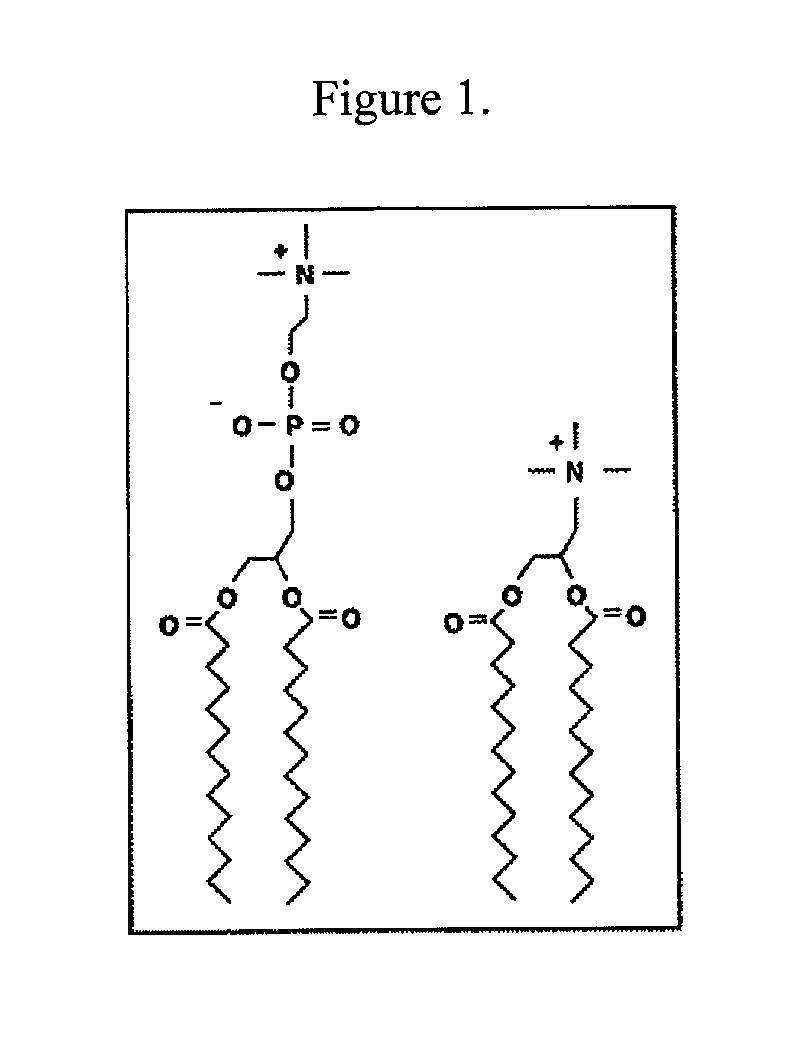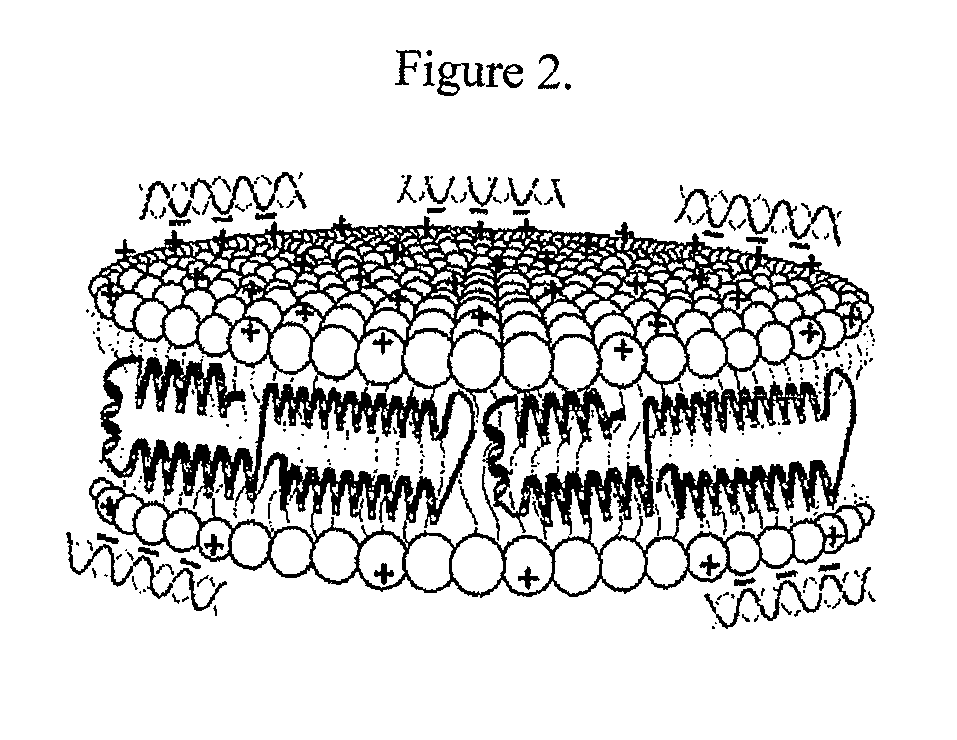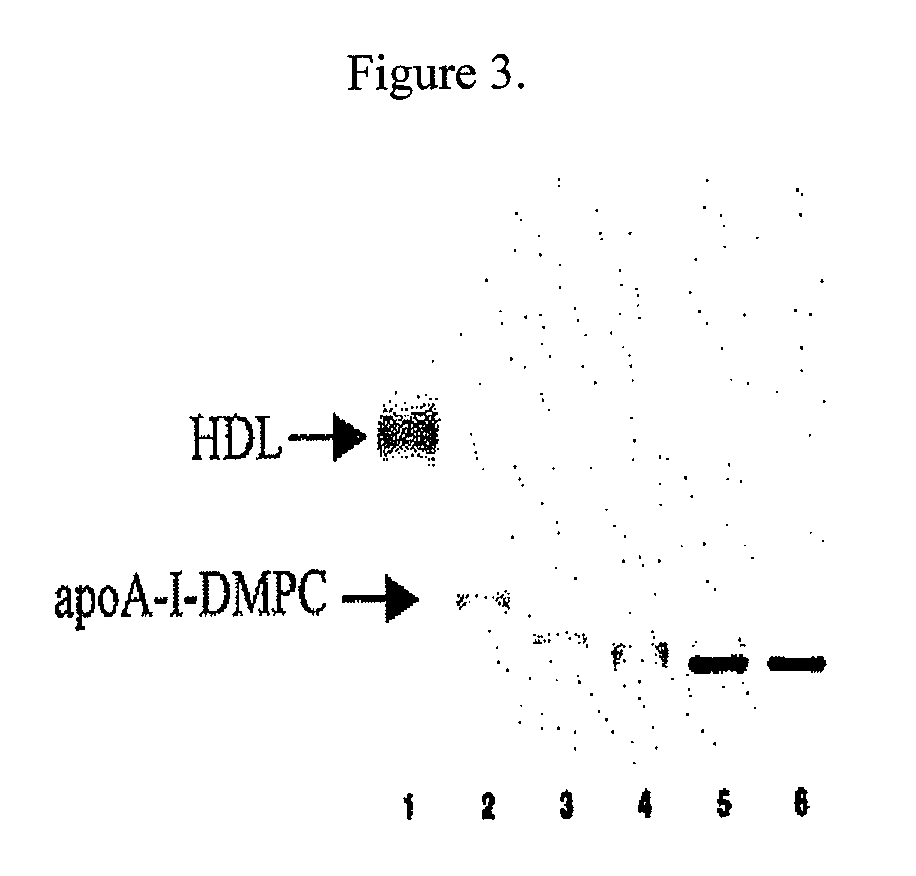Lipophilic nucleic acid delivery vehicle and methods of use thereof
a nucleic acid and lipophilic technology, applied in the direction of biocide, genetic material ingredients, biochemistry apparatus and processes, etc., can solve the problems of inability to deliver sirnas and other nucleic acid-based therapeutics systemically to cells, and the inability to meet the needs of in vitro clinical applications of such therapeutics, so as to increase the stability of the particl
- Summary
- Abstract
- Description
- Claims
- Application Information
AI Technical Summary
Benefits of technology
Problems solved by technology
Method used
Image
Examples
example 1
Preparation and Characterization of Lipophilic Nucleic Acid Delivery Particles
Preparation of Recombinant ApoA-I
[0129]Recombinant Apo-A-I was prepared as described in Ryan et al. (2003) Prot. Expr. Purif. 27:98-103, and was used to prepare Apo-A-1-cationic lipid particles as described below.
Preparation of Cationic Lipid Nanodisks
[0130]Initial experiments used the commercially available cationic lipid dimyristoyltrimethylammonium propane (DMTAP; see FIG. 1). The amount of DMTAP was systematically increased from 0 to 50% in 10% increments, and the amount of dimyristoylphosphatidylcholine (DMPC) used systematically decreased in 10% increments. Lipid bilayers prepared with varying ratios of DMTAP to DMPC were made with apolipoprotein (“apo”) A-I. Other scaffold proteins and peptides will be incorporated in the future. The data showed that apolipoprotein (“apo”) A-I efficiently induced formation of nanodisk particles at DMTAP amounts up to 30% (w / w) versus DMPC amounts increasing from 70%...
example 2
Knockdown of GAPDH Expression by Nucleic Acid Delivery Particles Comprising an siRNA
[0138]siRNA-loaded cationic lipid nanodisks are compared to conventional cationic lipid transfection reagents in gene knockdown experiments. Targeting of siRNA to cell surface endocytic receptors is investigated using nanodisk particles generated with apoE or apoA-I as the scaffold protein.
[0139]For siRNA gene knockdown experiments, the KDalert™ GAPDH Assay Kit (Ambion, Inc., Austin, Tex.) is used according to the manufacturer's instructions, modified as discussed below. The KDalert™ GAPDH Assay Kit is designed as an assessment tool for siRNA transfection optimization, and is used to measure gene silencing or knockdown of GAPDH (glyceraldehyde 3-phosphate dehydrogenase) at the protein level. In this assay, Hep3B or HEK 293 cells are transfected with GAPDH siRNA or negative control siRNA. Efficacy of cationic lipid nanodisks as transfection reagent is assessed using GAPDH-specific siRNA and negative c...
example 3
Long Term Stability of Nucleic Acid Delivery Particles
[0141]Recombinant ApoE3NT-terminal domain (ApoE3NT) is prepared as in Fisher et al. (1997) Biochem Cell Biol 75:45-53. ApoE3NT-containing particles are prepared via the cholate dialysis method described above, and used to assess long-term stability of the cationic lipid-containing nanodisks without nucleic acid.
[0142]Stability of nanodisk particles is assessed by native PAGE 4-20% gradient slab gel of particles stored in phosphate buffer at 4° C., stored in phosphate buffer at −20° C., or frozen in phosphate buffer at −80° C., lyophilized, and redissolved in H2O prior to analysis. The size and mobility of the cationic lipid-containing particles were unaffected by freezing and thawing, or by lyophilization and resolubilization, indicating that the particles retained their integrity under these conditions. These are important parameters with regard to scale up and long-term storage of nucleic acid delivery particles.
[0143]Those exp...
PUM
| Property | Measurement | Unit |
|---|---|---|
| diameter | aaaaa | aaaaa |
| Stokes' diameter | aaaaa | aaaaa |
| diameter | aaaaa | aaaaa |
Abstract
Description
Claims
Application Information
 Login to View More
Login to View More - R&D
- Intellectual Property
- Life Sciences
- Materials
- Tech Scout
- Unparalleled Data Quality
- Higher Quality Content
- 60% Fewer Hallucinations
Browse by: Latest US Patents, China's latest patents, Technical Efficacy Thesaurus, Application Domain, Technology Topic, Popular Technical Reports.
© 2025 PatSnap. All rights reserved.Legal|Privacy policy|Modern Slavery Act Transparency Statement|Sitemap|About US| Contact US: help@patsnap.com



